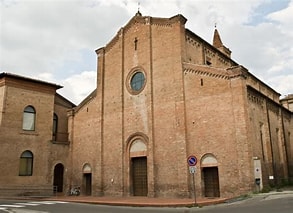Chiesa di San Francesco (XI Secolo) - inagibile

Il complesso della Chiesa di San Francesco è uno dei più antichi della città. Unitamente al limitrofo convento francescano, compare già nel primissimo assetto urbano risalente al XIII Secolo. La Chiesa di San Francesco, dai richiami gotici, figura tra le prime chiese francescane d'Italia, poichè costruita subito dopo la canonizzazione del Santo. Pur con lievi modifiche, assume l'aspetto attuale solo all'inizio del XV Secolo. L'importanza dell'edificio è sottolineata dal ruolo "pantheon" della famiglia Pico: al suo interno, infatti, sono custodite delle splendite tombe di Galeotto (1499), Prendiparte (1399 - opera di Paolo delle Masegne), di Spinetta (1399), ed infine di Giovan Francesco I e Giulia Boiardo, i genitori di Giovanni Pico (1467).
Attualmente la Chiesa di San Francesco non è agibile a seguito dei violenti eventi sismici di maggio 2012.
St. Francis' Church (11 th Century)
The complex of the Church of San Francesco is one of the oldest in the city. Together with the neighboring Franciscan convent, it already appears in the very first urban layout dating back to the thirteenth century. The Church of San Francesco, with Gothic references, is among the first Franciscan churches in Italy, as it was built immediately after the canonization of the Saint. Although with slight changes, it took on its current appearance only at the beginning of the fifteenth century. The importance of the building is underlined by the "pantheon" role of the Pico family: inside, in fact, there are splendid tombs of Galeotto (1499), Prendiparte (1399 - the work of Paolo delle Masegne), Spinetta (1399), and finally of Giovan Francesco I and Giulia Boiardo, the parents of Giovanni Pico (1467). Currently the Church of San Francesco is not accessible following the violent seismic events of May 2012.
Testi a cura di La Nostra Mirandola
